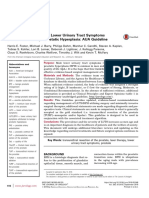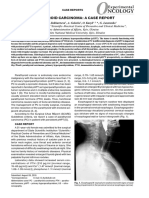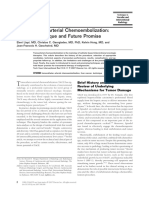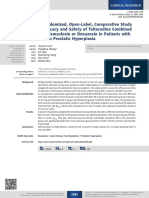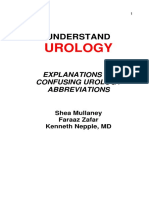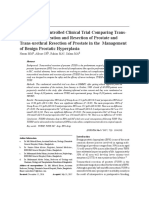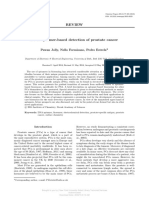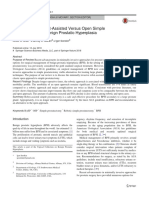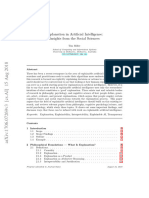Professional Documents
Culture Documents
Prostataarterienembolisation: Indikation, Technik Und Klinische Ergebnisse
Prostataarterienembolisation: Indikation, Technik Und Klinische Ergebnisse
Uploaded by
Eliana Solange FouzOriginal Title
Copyright
Available Formats
Share this document
Did you find this document useful?
Is this content inappropriate?
Report this DocumentCopyright:
Available Formats
Prostataarterienembolisation: Indikation, Technik Und Klinische Ergebnisse
Prostataarterienembolisation: Indikation, Technik Und Klinische Ergebnisse
Uploaded by
Eliana Solange FouzCopyright:
Available Formats
Review
Prostate Artery Embolization: Indication, Technique and Clinical
Results
Prostataarterienembolisation: Indikation, Technik und klinische
Ergebnisse
Authors
Ulf Teichgräber1, René Aschenbach1, Ioannis Diamantis1, Friedrich-Carl von Rundstedt2, Marc-Oliver Grimm2,
Tobias Franiel1
This document was downloaded for personal use only. Unauthorized distribution is strictly prohibited.
Affiliations bolization has no impact on erectile function and is associated
1 Department of Radiology, University Hospital Jena, with a relatively low complication rate.
Germany Conclusion PAE is increasingly developing to an alternative
2 Department of Urology, University Hospital Jena, Germany for the established surgical treatments in BPS patients.
Key words Key Points
prostate artery embolization, benign prostate syndrome, ▪ PAE is a new embolization method for treating BPS and
lower urinary tract symptoms represents an alternative to classic urological surgical pro-
cedure such as TURP.
received 13.12.2017 ▪ Due to the low caliber of the prostate artery (0.5 – 2 mm),
accepted 24.03.2018 the presence of anatomical variations, and the arterio-
Bibliography sclerosis seen in most older men, PAE is a technically chal-
DOI https://doi.org/10.1055/a-0612-8067 lenging embolization method.
Published online: 2018 ▪ In patients with a high postoperative bleeding risk in clas-
Fortschr Röntgenstr sic urological surgical treatment concepts, PAE is a very
© Georg Thieme Verlag KG, Stuttgart · New York gentle alternative method.
ISSN 1438-9029 Citation Format
▪ Teichgräber U, Aschenbach R, Diamantis I et al. Prostate
Correspondence
Artery Embolization: Indication, Technique and Clinical
Prof. Dr. med. Ulf Teichgräber
Results. Fortschr Röntgenstr 2018; DOI 10.1055/a-0612-
Institut für Diagnostische und Interventionelle Radiologie,
8067
Universitätsklinikum Jena, Am Klinikum 1,
07747 Jena, Germany Z US A M M E N FA SS U N G
Tel.: ++ 49/36 41/9 32 48 31
Fax: ++ 49/36 41/9 32 48 32 Hintergrund Die Prostataarterienembolisation (PAE) ist ein
[email protected] junges Embolisationsverfahren zur Behandlung des benignen
Prostatasyndroms (BPS).
ABSTR AC T Material und Methode In dieser Übersichtsarbeit werden
Background Prostate artery embolization (PAE) is a new em- die Rationale und Wirkungsmechanismen der PAE vorgestellt
bolization therapy to treat benign prostate syndrome (BPS). und die Patientenauswahl sowie die Anatomie der Prostataar-
Materials and Methods This review article presents the terien diskutiert. Die Studienergebnisse werden im Kontext
rationale and impact mechanism of PAE, criteria for patient von klinischen Ansprechraten und Komplikationen betrachtet.
selection, and discusses the anatomy of prostate arteries. Ergebnisse Wichtige Voraussetzungen für die erfolgreiche
The study results are seen in the context of complications Prostataarterienembolisation sind eine strenge Indikations-
and clinical partners. stellung, eine genaue Kenntnis der Anatomie der Beckenar-
Results Important preconditions for successful prostate terien und ein hohes interventionell-radiologisches Können.
artery embolization are a strict indication, precise knowledge Mehrere Studien konnten zeigen, dass sich die urologischen
of the anatomy of the pelvic arteries and advanced interven- Erfolgsparameter nach einer Prostataarterienembolisation in
tional-radiological skills. Several studies showed that urolo- einem ähnlichen Maß verbessern wie nach einer Therapie mit
gical parameters after prostate artery embolization improve einem etablierten chirurgischen Verfahren. Gleichzeitig
at a similar level as for established post-surgical treatments. konnte gezeigt werden, dass die PAE mit einer unveränderten
At the same time, it could be proven that prostate artery em- Erektionsfähigkeit und einer nur geringen Komplikationsrate
einhergeht.
Teichgräber U et al. Prostate Artery Embolization:… Fortschr Röntgenstr
Review
Schlussfolgerung Die PAE entwickelt sich für Patienten mit chirurgischen Therapieverfahren.
einem BPS zunehmend zu einer Alternative zu den etablierten
(Holmium-Laser-enucleation of the prostate) and photoselective
Introduction
vaporization of the prostate (PVP) with a GreenLight laser are al-
Prostate artery embolization (PAE) is a new embolization method ternatives to TURP. These treatment methods can be optionally
for treating benign prostate syndrome (BPS) which was first pres- used for glands ≤ 80 ml. Open prostate adenoma enucleation is
ented in 2010 in two interventional-radiological case descriptions often performed for larger glands. PAE can be performed as an al-
[1]. It was basically a “proof-of-principle” that directed the interest ternative to surgery regardless of the size of the prostate.
not only of the interventional radiologists, but also the affected
patients towards this minimally invasive method.
This document was downloaded for personal use only. Unauthorized distribution is strictly prohibited.
Rationale/impact mechanisms of PAE
BPS – etiology, clinical picture, treatment The effect of PAE is based on multiple impact mechanisms. Embo-
lization causes displacement of intraprostatic vessels and preca-
with medication and surgical treatment pillary arterioles, resulting in irreversible ischemia. An inflamma-
Typical symptoms for benign prostate syndrome (BPS) include tory response and the formation of edema then result in ideally
lower urinary tract syndroms (LUTS) and bladder outlet obstruc- complete anoxia. The shrinking process begins after absorption
tion (BOO). [2]. Bladder outlet obstruction is caused by a benign of the edema components and scar formation. At the same time
enlargement of the prostate (benign prostate hyperplasia – BPH). the level of intraprostatic testosterone and of converted highly
Strictly speaking, BPH is a histological diagnosis associated with biochemically active dihydrotestosterone (DHT) decrease. Both
proliferation of stromal and epithelial cells [2, 3]. The greater pro- effects lead to the shrinkage of the prostate [6]. The administra-
liferation of stromal and epithelial cells in combination with the tion of the adequate particle size is essential to support shrinkage.
decreased programmed cell death results in both fibroadenoma- A deep penetration and a too proximal embolization increase the
tous hyperplasia and an increase in gland tissue [2, 3]. This cell risk for urethral necrosis. By destroying the intraprostatic nerve
proliferation is regulated by androgens, estrogens, and growth ends, successful embolization results in a reduction of the α1-
factors. The most important androgen is testosterone which is al- adrenergic receptor density causing relaxation of the smooth
most fully converted in the prostate by type II 5α reductase into muscle cells [7]. In BPH, the density of the α1-adrenergic recep-
biologically active dihydrotestosterone (DHT) [4]. Type II 5α re- tors is approx. 6-times higher than in the normal prostate and in-
ductase also plays an important role in the development of hyper- duces the relaxation of smooth muscle cell tonus within the blad-
plasia [4, 5]. der neck affecting the flow from the bladder into the urethra. The
Prostate size and symptoms are not necessarily correlated. The receptor expression drops significantly after embolization result-
symptoms of BPS can be classified as obstructive symptoms ing in a decrease in muscle tone. This may explain the reported
(emptying phase) and irritative micturition syndrome (storage early clinical successes after PAE, also due to the notable reduc-
phase) [2]. The symptoms of the emptying phase include delayed tion in prostate volume [9, 10].
start of micturition, prolonged micturition time, weakening of the
urine stream and a feeling of incomplete emptying of the bladder
[2]. Increased nycturia, frequent urination of small amounts, invo- Patient selection
luntary urge to urinate and dysuria are symptoms of the storage Important diagnostic predictors for symptomatic BPS are age
phase [2]. (≥ 60 years), urodynamic examinations including maximum urine
The indication for BPS treatment is determined based on the stream (Qmax, uroflowmetry), postvoid residual volume (PVR) and
symptoms and the effect on quality of life. BPS is basically treated the determination of the prostate volume via transrectal ultra-
with α 1-adrenoreceptor antagonists (e. g. tamsulosin, alfuzosin) sound (TRUS). The severity of the patient’s symptoms caused by
which relax the smooth muscles of the bladder neck, the prostate, BPH can be best determined using the International Prostate
and the urethra [2]. Alternatively or additionally, 5α-reductase in- Symptom Score (IPSS) questionnaire, which includes 7 questions
hibitors (e. g. finasteride, dutasteride) can be administered to re- regarding BPH symptoms. In addition, the IPSS questionnaire in-
duce the prostate volume by decreasing the size of the prostate cludes one question regarding quality of life (QoL). Symptoms
glands [2]. If treatment with medication is refractory, surgical are rated on a scale of 0 to 5 points (0 = no symptoms and 5 = se-
therapy can be considered [2]. The gold standard is transurethral vere symptoms). The maximum total number of points is 35.
resection of the prostate (TURP). The enlarged transitional zone is Based on this self-evaluation by the patient, a total point value
resected endoscopically via the urethra with the sphincter and the < 8 corresponds to minimal symptoms, 8 – 19 to moderate symp-
seminal colliculus being preserved. The enlarged prostate is re- toms, and 20 – 35 to severe symptoms. The PSA value must be
sected in layers via monopolar or bipolar current and possible evaluated with respect to the risk of prostate cancer since BPH
bleeding is stopped. Laser treatment methods such as HoLEP can result in an increase in the PSA value. In case of suspicion of
Teichgräber U et al. Prostate Artery Embolization:… Fortschr Röntgenstr
renal insufficiency due to a blockage, the serum creatinine must
▶ Table 1 Requirements for prostate artery embolization.
also be taken into consideration to evaluate BPH. Therefore, colla-
boration with urology is essential for determining the indication
prostate vol. > 30 ml
for PAE. The requirements for PAE are summarized in ▶ Table 1
and the contraindications in ▶ Table 2. IPSS: ≥ 18
Under consideration of the fact that symptomatic BPH usually QoL: ≥ 3
occurs in the 6th to 7th decade of life in men, patients often also IEFF: only monitoring
have comorbidities so that urological surgical methods are asso- Qmax: ≤ 15 ml/s at micturition volume of min. 150 ml
ciated with an increased risk. The postoperative bleeding risk
postvoid residual volume: only monitoring, no upper or lower limit
must be mentioned here in particular [11]. There is a very high
postoperative bleeding risk in the case of classic urological surgi-
cal treatment concepts in patients undergoing continuous antico-
agulation therapy such as dual antiplatelet therapy or phenpro-
coumon (Marcumar®) after stroke or heart attack or in patients ▶ Table 2 Contraindications for prostate artery embolization.
This document was downloaded for personal use only. Unauthorized distribution is strictly prohibited.
with cardiovascular implants. PAE is an alternative to TURP and
prostate cancer
open enucleation of the prostate even in patients with a prostate
volume > 65 ml since the complication rate of urological surgical large bladder diverticula or bladder concretions (relative)
procedures with urogenital infections and postoperative bleeding acute infections (prostatitis, urethritis)
increases greatly in the case of larger prostate volumes. Particu- urethral strictures
larly younger, sexually active patients fear retrograde ejaculation,
neurogenic bladder dysfunction
which can be a normal consequence of TURP in over 75 % of pa-
pronounced arteriosclerosis (relative)
tients. Erectile dysfunction following surgery, which is frequently
mentioned as a complication, is rarer (0.5 – 1 %). There is also a renal insufficiency (eGFR < 60 ml/min)
fear of urinary incontinence so that PAE is a good alternative to
standard surgical procedures in this patient group. In our many
years of experience with PAE, we have worked in close collabora-
tion with urology to determine indications for which PAE is now ▶ Table 3 Indications for prostate artery embolization.
our first-choice treatment method (▶ Table 3).
patients with special risks regarding surgery/anesthesia (after myocar-
dial infarction, anticoagulation)
Technique sexually active men (risk of retrograde ejaculation in standard methods)
prostate vol. > 65 ml (alternative to open prostate adenomectomy)
PAE is performed under local anesthesia at the inguinal puncture
site. Additional intravenous pain medication is usually not neces- refractory BPS medication
sary. A urinary catheter should be inserted. The catheter is used permanent bladder catheter
for orientation during PAE and also makes the intervention signif- recurrent bleeding caused by BPH
icantly easier for the patient by allowing unobstructed urine flow.
The standardized PAE method as practiced by us in interven-
tional radiology is described step-by-step in the following. The performed by positioning the guide catheter in the left and right
first step is retrograde puncture of the right common femoral internal iliac arteries separately for each side. The side on which
artery and insertion of a short 5F catheter. As a rule, bilateral em- the intervention is started does not affect treatment success. We
bolization of the prostate arteries is targeted. To identify the ana- routinely begin with probing of the left internal iliac artery with
tomical vascular conditions and in particular the origin of the a 4F RIM catheter (e. g. Merit Medical, Salt Lake City, USA) as the
prostate arteries on both sides, it is recommended to acquire an guide catheter. Alternatively, a 5F “Roberts Uterine” catheter
arterial rotation CT angiography scan (cone-beam CT). A pigtail (e. g. Cook, Bloomington, IN), a 5F Sidewinder catheter or a “Pisco
or RIM angiography catheter is first inserted via the introducer. Prostatic” catheter developed specifically for PAE (e. g. Merit Med-
The catheter tip should be positioned above the bifurcation of ical, Salt Lake City, USA) can be used. However, it must be taken
the common iliac artery in the distal abdominal aorta since even into consideration that both of these alternative probe catheters
an atypical origin of the prostate artery can be reliably detected in must first be configured for the intended purpose via the pelvic
this position (▶ Fig. 1). The rotation CT angiography scan of the axis which requires a cross-over maneuver. If the cross-over
pelvic arteries was acquired with a total of 90 ml of a contrast maneuver is not successful, a second access can be alternatively
agent/Na-Cl mixture (60 %/40 %), an injection rate of 8 ml/s, and created on the contralateral side to again attempt to probe the
an X-ray delay of 7 s using pre-warmed contrast agent with an ipsilateral internal iliac artery.
iodine concentration of 250 mg/ml. The internal iliac arteries and Using and comparing the 3 D reconstruction as maximum in-
their branches can be fully visualized on both sides on a rotation tensity projections (MIP) of the rotation CT angiography scan,
angiography scan with a total detector width of 30 – 40 cm. If the origin of the prostate artery is identified and the optimum an-
this is not technically feasible, rotation CT angiography can be gulation for later probing is determined (▶ Fig. 2, 3). Alternatively,
Teichgräber U et al. Prostate Artery Embolization:… Fortschr Röntgenstr
Review
This document was downloaded for personal use only. Unauthorized distribution is strictly prohibited.
▶ Fig. 2 Origin of the prostate artery (PA) from the internal puden-
▶ Fig. 1 Rare variant of the origin of the obturator artery with the
dal artery; shown on cone-beam CT as MIP a and on corresponding
prostate artery (PA) from the external iliac artery; shown on cone-
overview angiography b. Selective probing and visualization of the
beam CT a and overview angiography b. Selective probing and
distal prostate artery with contrast enhancement of the prostate
visualization of the distal prostate artery with contrast enhance-
parenchyma pa c and final image after successful embolization
ment of the prostate parenchyma pa c and final image after
(flow stop) of the prostate artery d.
successful embolization of the prostate artery d.
the embolization technique with multiple catheter positions (PEr-
manual overview angiography with ipsilateral alignment of the
FecTED method) [14], we prefer a technique with a catheter posi-
detector of 30 – 40° oblique and caudocranial angulation of 10 –
tion with small biocompatible 250 µm Embozene Microspheres
15° can be performed to identify the prostate artery (▶ Fig. 4). A
(Boston Scientifics, Natick, MA, USA). The Embozene Micro-
microcatheter is then inserted using the coaxial technique. We
spheres are combined in a precisely defined ratio depending on
use the 2.7F Progreat α (Terumo, Tokyo, Japan) catheter as the
the contrast agent being used so that the microspheres remain
standard microcatheter. Alternatively, a 2.0F Progreat α (Terumo,
in suspension as long as possible and sedimentation does not oc-
Tokyo, Japan) with a 0.014 inch Cirrus guide wire (Cook, Bloo-
cur. For complete unilateral embolization of the prostate artery,
mington, IN, USA) can be used. The prostate artery has an average
fewer than 0.5 ml of microspheres are generally needed (more in
diameter of 0.9 mm (range: 0.5 – 1.5 mm) and usually originates
a mixture with contrast agent). The end goal of embolization is
from the internal pudendal artery or from a common origin with
reached upon “flow stop” of the microspheres/contrast agent
the superior vesical artery [12, 13]. The exact anatomical condi-
mixture. Reflux should be avoided. To test the success of the pro-
tions and vessel variations are explained in greater detail below.
cedure, the microcatheter is retracted slightly into the prostate
The prostate artery must be superselectively probed with the
artery and a control angiography scan is performed via manual in-
microcatheter. The prostate is typically supplied from one side by
jection of 1 ml of contrast agent. This angiography scan should be
only one main branch of the prostate artery. Directly in front of
performed slowly and with the least amount of pressure possible
the prostate, the prostate artery divides into a cranial branch for
(manual injection rate approx. 0.2 ml/s). After completion of em-
supplying the central gland parts and a lateral branch for supply-
bolization on the contralateral side, the microcatheter is removed
ing the peripheral zone (▶ Fig. 5). It should be taken into consid-
and the ipsilateral internal iliac artery is probed with the RIM cath-
eration that the urethral and capsular branches must also be em-
eter. PAE is then repeated on the ipsilateral side in the same man-
bolized. Embolization of the inferior vesical artery with branches
ner as previously described. The embolization procedure is very
to the seminal vesicles and bladder wall should be avoided.
short in our preferred embolization technique. However, probing
Deviating from the frequently quoted embolization with mi-
of the prostate artery can be very time-consuming depending on
crospheres with 150 – 250 µm polyvinyl alcohol (PVA) particles
the anatomical vessel variations with elongated iliac arteries and
(Cook, Bloomington, IN, USA) with a size of 300 – 500 µm (Embo-
arteriosclerotic vessels with kinking or stenosis at the origin of
sphere 300 – 500 µm, Merit Medical, Salt Lake City, USA) [11] or
the prostate artery (▶ Fig. 6). It must be taken into consideration
Teichgräber U et al. Prostate Artery Embolization:… Fortschr Röntgenstr
This document was downloaded for personal use only. Unauthorized distribution is strictly prohibited.
▶ Fig. 5 Prostate artery with two cranial branches for supplying the
central parts of the prostate and a lateral branch for primarily sup-
plying the peripheral zone.
that fluoroscopy times can exceed 60 minutes in individual cases,
▶ Fig. 3 Origin of the prostate artery (PA) from the superior gluteal particularly in the establishment phase of PAE. However, we have
artery; shown on cone-beam CT as MIP a and on corresponding found that fluoroscopy times decrease with an increase in experi-
overview angiography b. Selective probing and visualization of the ence.
distal prostate artery with contrast enhancement of the prostate
parenchyma pa c and final image after successful embolization of
the prostate artery d.
Anatomy of prostate arteries
Based on anatomical textbooks with visualization of the origins of
the individual branches from the internal iliac artery, the German
mnemonic used in anatomy lessons for the vessel branches of the
internal iliac artery of the female pelvis can also be applied to the
male pelvis (“Ingo sass Glut-glühend oben, um sich Blase, Prostata
und Rektum zu pudern”) (▶ Table 4). Accordingly, the prostate
artery typically originates as the 9th branch together with the
superior vesical artery from the internal iliac artery. The prostate
artery then runs obliquely in a caudal direction and reaches the
prostate under the bladder anteromedially. Over its course, there
are typically branches to the seminal vesicles and also the base of
the bladder especially since a common origin of the superior and
inferior vesical artery and the prostate artery is routinely seen.
The anatomical conditions of the arterial branches from the inter-
nal iliac artery are schematically shown in ▶ Fig. 7. However, this
is a highly idealized representation. Bilhim et al. analyzed anato-
mical variations in 75 PAE patients based on angio-CT and the an-
giography scan performed immediately prior to PAE [15]. The
most common origin of the prostate artery was seen in the mid-
dle third of the internal pudendal artery in 34 % of cases (▶ Fig. 2).
A common origin of the prostate artery and the superior vesical
▶ Fig. 4 Overview angiography of the branches of the internal iliac
artery was observed in only 20 % of cases (▶ Fig. 6). However, it
artery with origin of the prostate artery (PA) from the anterior bundle.
must be taken into consideration that the currently available ana-
lyses and experience are based on only a relatively small number
of patients. Thus, the mnemonic provides only basic orientation
for locating the prostate artery. An important observation is also
Teichgräber U et al. Prostate Artery Embolization:… Fortschr Röntgenstr
Review
▶ Table 4 German anatomy mnemonic for the arterial branches from
the internal iliac artery adapted for the male pelvic arteries (number-
ing, see ▶ Fig. 7).
ingo 1 A. iliolumbalis
sass 2 A. sacralis interna
glut 3 A. glutaea superior
glühend 4 A. glutea inferior
oben 5 A. obturatoria
um 6 A. umbilicalis
sich 7 A. vesicalis sup.
blase, 8 A. vesicalis inf.
This document was downloaded for personal use only. Unauthorized distribution is strictly prohibited.
prostata und 9 A. prostatica
rectum zu 10 A. rectalis media
pudern 11 A. pudenda interna
▶ Fig. 6 Severe stenosis of common origin (arrow) of the prostate
artery (PA) with superior and inferior vesical artery.
that two independent prostate arteries were observed per pelvis
side in 43 % of cases [15]. On average, 2.9 ± 0.9 prostate arteries
per patient were identified in the small collective. In our experi-
ence, small anastomoses or collateral vessels from the prostate
artery to the medial rectal artery, internal pudendal artery, or
inferior vesical artery can be identified in approx. one third of all
patients (▶ Fig. 8). Depending on the extent, either a slightly
more distal catheter position or larger microspheres should be
selected for embolization. In the case of pronounced anasto-
moses, e. g. to the posterior bladder wall, we use 400 µm instead
of 250 µm microspheres. Anastomoses to the opposite side of the
prostate are also observed in 20 % of all patients (▶ Fig. 9). This
also seems to be a reason for the clinical success of unilateral PAE
in many cases [11].
Patient management
The night before or morning of the intervention, our patients re-
ceive a single dose of an antibiotic (e. g. 500 mg of ciprofloxacin
po) in combination with a non-steroidal antirheumatic agent in an
antiphlogistic concentration (e. g. 800 mg of ibuprofen po) and
40 mg of omeprazole po as premedication. If a patient does not
tolerate iodine-containing contrast agents, premedication is ad- ▶ Fig. 7 Schematic representation of the arterial branches origi-
ministered at the ward. In general, patients do not experience nating from the internal iliac artery: 1: Iliolumbar artery, 2: Internal
pain during or after PAE. 40 drops of Novalgin® (metamizole) can sacral artery, 3: Superior gluteal artery, 4: Inferior gluteal artery,
5: Obturator artery, 6: Umbilical artery, 7: Superior vesical artery,
be administered as needed in the case of postembolization syn-
8: Inferior vesical artery, 9: Prostate artery, 10: Superior rectal
drome or 2 × 1 tablet 10/5 mg of Targin® extended release (oxyco- artery, 11: Internal pudendal artery, 12: Inferior rectal artery,
done + naloxone) po in the case of significant pain. 1 mg of gran- 13: Perineal artery, 14: Dorsal penile artery.
isetron in 100 ml of isotonic NaCL as a short i. v. infusion or 3 × 30
drops of metoclopramide can be administered in the case of nau-
sea and vomiting. After the intervention, antibiotic and antiphlo- 2× daily 250 mg of ciprofloxacin + 800 mg of ibuprofen + 40 mg of
gistic therapy should be continued for an additional 10 days (e. g. omeprazole). Shrinkage starts approximately 1 month after embo-
Teichgräber U et al. Prostate Artery Embolization:… Fortschr Röntgenstr
This document was downloaded for personal use only. Unauthorized distribution is strictly prohibited.
▶ Fig. 8 Collaterals of the prostate artery with the internal pudendal artery a. After supraselective probing of the collateral vessel b and another
check at an optimized angle c, a microcoil is placed d.
▶ Fig. 9 Strong collaterals of the lateral branch of the prostate artery to the anus (arrow in a). Visualization of the strong collaterals of the ipsilateral
prostate artery to the opposite side and contrast enhancement of the entire prostate b after placement of a coil in the lateral branch (arrow). Final
image after successful embolization of the prostate artery c.
lization. Since the effect of decreased tone of the smooth muscles mum urine flow (Q max ) by 5.3 ml/s, the prostate volume by
is insufficient in some patients, we recommend continuing BPS –29.8 ml, postvoid residual volume by –66.9 ml, the International
medication for one month. This medication can then be discontin- Index for Erectile Function (IIEF) by 1.3 points and the PSA value by
ued in coordination with the treating urologist. During the in- –0.8 ng/ml. This corresponded to an improvement among study
formed consent discussion, patients should be explicitly informed patients of 31 – 85 % for IPSS, 29 – 81 % for QoL, 17 – 132 % for
of the newness of the method and the lack of long-term results. Qmax, 5 – 45 % for prostate volume, 35 – 76 % for postvoid
For this reason, patients should ideally be examined and treated residual volume and 0 – 18 % for IIEF [16].
under study conditions. In our opinion, this also includes follow- To date, data from 3 comparative studies with a total of 297
up of the patient after 1, 3, 6 and 12 months with recording of patients has been published (149 patients in the PAE group and
the IPSS, QoL, IIEF, Qmax, postvoid residual volume, prostate vol- 148 patients in the control group TURP or open adenomectomy)
ume, and any side effects. [17 – 19]. These data were able to show that the length of hospital
stay in the PAE group was shorter than in the control group
(median 2.5 days vs. 4.8 days) however with a slightly longer in-
Study results tervention time (90 min vs. 62 min) [16]. The largest comparative
study with a total of 114 patients (randomization ratio 1:1) did not
750 patients from 13 studies with a follow-up period of 3 – 12
show a statistically significant difference between the values for
months were further evaluated in a current metaanalysis [16]. A
IPSS, QoL, Q max , and postvoid residual volume 6 months after
significant improvement in the observed endpoints compared to
PAE or TURP [17]. According to the study register “clinicaltrial.
the baseline values was seen in these patients [16]. In detail, the
gov”, an additional 3 clinical studies (NCT01789840,
IPSS improved by –12.8 points, the QoL by –2.3 points, the maxi-
Teichgräber U et al. Prostate Artery Embolization:… Fortschr Röntgenstr
Review
NCT02054013, NCT02566551) comparing PAE vs. TURP are cur- sis of the prostate and does not have clinical significance. How-
rently active. One study is a non-randomized multicenter study ever, this complication can also rarely be the result of misembo-
while the other two studies are controlled randomized single-cen- lization of the seminal vesicles. In the literature acute urinary
ter studies. Moreover, a controlled randomized single-center retention is a common complication seen in 9.4 % of cases (14/
study is recruiting patients for the comparison PAE vs. placebo 149) [18]. In our own patients, we have not observed this compli-
and a further controlled randomized multi-center study is recruit- cation since the periinterventional administration of non-steroidal
ing patients for the comparison PAE vs. medication. For this rea- antirheumatic drugs in an antiphlogistic dose. Further minor com-
son, additional study data regarding the efficacy of PAE can cer- plications of PAE described in the literature in descending order of
tainly soon be expected. Only non-randomized single-center frequency are post-embolization syndrome (4 %), hematuria
observational studies or retrospective case cohorts examining (3.4 %), urinary tract infections (2.7 %), increase in urge symptoms
which particles and which particle size should be used and what (2.0 %), hematospermia (0.7 %), transient rectal bleeding (0.7 %),
effect the volume of the prostate, the patient’s age, and the uni- transient ischemia of the pubic bone (0.7 %), and transient pelvic
lateral or bilateral embolization have on the success of PAE are pain (0.7 %) [16, 24].
available. It was able to be that spherical polyvinyl alcohol parti-
This document was downloaded for personal use only. Unauthorized distribution is strictly prohibited.
cles (sPVA) and non-spherical polyvinyl alcohol particles (nsPVA) Conflict of Interest
are equally effective for prostate artery embolization [20]. With
respect to the particle size being used, 100 µm nsPVA compared The authors declare that they have no conflict of interest.
to 200 µm nsPVA yielded a greater reduction of the prostate vol-
ume and the PSA value, while 200 µm nsPVA was associated with a Literatur
higher clinical success rate [21]. sPVA size did not affect the re-
lapse rate after 12 months [22]. Prostate volume does not seem [1] Carnevale FC, Antunes AA, da Motta Leal Filho JM et al. Prostatic artery
to have an effect on the outcome of PAE since there is no statisti- embolization as a primary treatment for benign prostatic hyperplasia:
cally significant differences for IPSS, QoL, and IIEF 6 months after preliminary results in two patients. Cardiovasc Intervent Radiol 2010;
treatment between the groups PV < 50 ml, PV 50 – 80 ml and PV 33: 355 – 361
> 80 ml [23]. In contrast, a younger age (≤ 65 years) and the bilat- [2] Burnett AL, Wein AJ. Benign prostatic hyperplasia in primary care: what
eral embolization of the prostate arteries seem to be associated you need to know. J Urol 2006; 175: 19 – 24
with improved clinical success [20]. [3] Berry SJ, Coffey DS, Walsh PC et al. The development of human benign
prostatic hyperplasia with age. J Urol 1984; 132: 474 – 479
[4] Walsh PC, Hutchins GM, Ewing LL. Tissue content of dihydrotestosterone
in human prostatic hyperplasis is not supranormal. J Clin Invest 1983; 72:
Complications 1772 – 1777
PAE is a very safe method under the condition that it is performed [5] Saartok T, Dahlberg E, Gustafsson JA. Relative binding affinity of anabol-
ic-androgenic steroids: comparison of the binding to the androgen
as a superselective embolization method for the prostate artery.
receptors in skeletal muscle and in prostate, as well as to sex hormone-
To date, only one case of accidental embolization of the posterior binding globulin. Endocrinology 1984; 114: 2100 – 2106
bladder wall in a series of 89 patients resulting in ischemia with
[6] Sun F, Sanchez FM, Crisostomo V et al. Benign prostatic hyperplasia:
bleeding and consecutive partial resection of the bladder wall transcatheter arterial embolization as potential treatment–preliminary
has been reported in the literature [11]. However, except for pos- study in pigs. Radiology 2008; 246: 783 – 789
sible misembolization, no major complications are to be expect- [7] Zlotta AR, Raviv G, Peny MO et al. Possible mechanisms of action of
ed. Therefore, it is even more important that the catheter position transurethral needle ablation of the prostate on benign prostatic hyper-
is checked ideally from two planes on angiography via the micro- plasia symptoms: a neurohistochemical study. J Urol 1997; 157: 894 –
899
catheter immediately prior to embolization. The position of the
prostate can be determined with the help of a bladder catheter [8] Nasu K, Moriyama N, Kawabe K et al. Quantification and distribution of
alpha 1-adrenoceptor subtype mRNAs in human prostate: comparison
blocked with contrast agent. In addition, comparison with a cur-
of benign hypertrophied tissue and non-hypertrophied tissue. Br J Phar-
rent prostate MRI examination should be performed prior to em- macol 1996; 119: 797 – 803
bolization. This double examination virtually rules out misemboli- [9] Carnevale FC, da Motta-Leal-Filho JM, Antunes AA et al. Quality of life
zation. and clinical symptom improvement support prostatic artery emboliza-
Typical complications of the endovascular embolization inter- tion for patients with acute urinary retention caused by benign prostatic
vention are primarily minor. Compared to UAE, the pain experi- hyperplasia. J Vasc Interv Radiol 2013; 24: 535 – 542
enced in PAE is negligible. In our experience which is in accord- [10] Pisco JM, Rio Tinto H, Campos Pinheiro L et al. Embolisation of prostatic
arteries as treatment of moderate to severe lower urinary symptoms
ance with the literature, some patients report a feeling of slight
(LUTS) secondary to benign hyperplasia: results of short- and mid-term
pressure or minimal pain in the pelvic region radiating into the
follow-up. Eur Radiol 2013; 23: 2561 – 2572
perineal region in the first two days after PAE. However, these
[11] Pisco JM, Pinheiro LC, Bilhim T et al. Prostatic arterial embolization to
issues can be well managed with oral analgesics. The large major- treat benign prostatic hyperplasia. J Vasc Interv Radiol 2011; 22: 11 – 19;
ity of patients are completely symptom-free after PAE. A few pa- quiz 20
tients can experience blood or coagulum in their ejaculate up to [12] Bilhim T, Pisco JM, Rio Tinto H et al. Prostatic arterial supply: anatomic
approx. one month after PAE as a possible late complication. This and imaging findings relevant for selective arterial embolization. J Vasc
is usually an embolization effect due to the initial stages of necro- Interv Radiol 2012; 23: 1403 – 1415
Teichgräber U et al. Prostate Artery Embolization:… Fortschr Röntgenstr
[13] Zhang G, Wang M, Duan F et al. Radiological Findings of Prostatic Arter- bolization (PAE) Due to Benign Prostatic Hyperplasia (BPH): Preliminary
ial Anatomy for Prostatic Arterial Embolization: Preliminary Study in 55 Results of a Single Center, Prospective, Urodynamic-Controlled Analysis.
Chinese Patients with Benign Prostatic Hyperplasia. PLoS One 2015; 10: Cardiovasc Intervent Radiol 2016; 39: 44 – 52
e0132678 [20] Bilhim T, Pisco J, Pereira JA et al. Predictors of Clinical Outcome after
[14] Amouyal G, Thiounn N, Pellerin O et al. Clinical Results After Prostatic Prostate Artery Embolization with Spherical and Nonspherical Polyvinyl
Artery Embolization Using the PErFecTED Technique: A Single-Center Alcohol Particles in Patients with Benign Prostatic Hyperplasia. Radiolo-
Study. Cardiovasc Intervent Radiol 2016; 39: 367 – 375 gy 2016; 281: 289 – 300
[15] Bilhim T, Pisco JM, Furtado A et al. Prostatic arterial supply: demonstra- [21] Bilhim T, Pisco J, Campos Pinheiro L et al. Does polyvinyl alcohol particle
tion by multirow detector angio CT and catheter angiography. Eur Radi- size change the outcome of prostatic arterial embolization for benign
ol 2011; 21: 1119 – 1126 prostatic hyperplasia? Results from a single-center randomized pro-
[16] Shim SR, Kanhai KJ, Ko YM et al. Efficacy and Safety of Prostatic Arterial spective study. J Vasc Interv Radiol 2013; 24: 1595 – 1602 e1591
Embolization: Systematic Review with Meta-Analysis and Meta-Regres- [22] Carnevale FC, Moreira AM, Harward SH et al. Recurrence of Lower Urin-
sion. J Urol 2017; 197: 465 – 479 ary Tract Symptoms Following Prostate Artery Embolization for Benign
[17] Gao YA, Huang Y, Zhang R et al. Benign prostatic hyperplasia: prostatic Hyperplasia: Single Center Experience Comparing Two Techniques.
arterial embolization versus transurethral resection of the prostate–a Cardiovasc Intervent Radiol 2017; 40: 366 – 374
This document was downloaded for personal use only. Unauthorized distribution is strictly prohibited.
prospective, randomized, and controlled clinical trial. Radiology 2014; [23] Bagla S, Smirniotopoulos JB, Orlando JC et al. Comparative Analysis of
270: 920 – 928 Prostate Volume as a Predictor of Outcome in Prostate Artery Emboliza-
[18] Russo GI, Kurbatov D, Sansalone S et al. Prostatic Arterial Embolization tion. J Vasc Interv Radiol 2015; 26: 1832 – 1838
vs Open Prostatectomy: A 1-Year Matched-pair Analysis of Functional [24] Uflacker A, Haskal ZJ, Bilhim T et al. Meta-Analysis of Prostatic Artery
Outcomes and Morbidities. Urology 2015; 86: 343 – 348 Embolization for Benign Prostatic Hyperplasia. J Vasc Interv Radiol 2016;
[19] Carnevale FC, Iscaife A, Yoshinaga EM et al. Transurethral Resection of 27: 1686 – 1697 e1688
the Prostate (TURP) Versus Original and PErFecTED Prostate Artery Em-
Teichgräber U et al. Prostate Artery Embolization:… Fortschr Röntgenstr
You might also like
- Smaple Resume 19 VIT PDFDocument2 pagesSmaple Resume 19 VIT PDFSantosh RathodNo ratings yet
- Benign Prostatic HyperplasiaDocument6 pagesBenign Prostatic HyperplasiaAnonymous 9OkFvNzdsNo ratings yet
- Theimpactofprostatesizemedianlobeandpriorbenignprostatichyperplasiainterventiononrobot Assistedlaparoscopicprostatectomy TechniqueandoutcomesDocument9 pagesTheimpactofprostatesizemedianlobeandpriorbenignprostatichyperplasiainterventiononrobot Assistedlaparoscopicprostatectomy TechniqueandoutcomesGordana PuzovicNo ratings yet
- Benign Prostate HyperplasiaDocument49 pagesBenign Prostate HyperplasiaRohani TaminNo ratings yet
- Komplikasi 2Document2 pagesKomplikasi 2Ayu PuspitaNo ratings yet
- HBP 2Document7 pagesHBP 2100064742No ratings yet
- 1 s2.0 S0753332220303103 MainDocument8 pages1 s2.0 S0753332220303103 Maindavid.arias.calidadNo ratings yet
- Ceju 69 00859Document5 pagesCeju 69 00859catur juliartiniNo ratings yet
- Imaging in BPHDocument6 pagesImaging in BPHadityaNo ratings yet
- Efficacy of Dexamethasone in Reducing The Postemobolisation Syndrome in Men Undergoing Prostatic Artery Embolisation For Benign Prostatic HyperplasiaDocument6 pagesEfficacy of Dexamethasone in Reducing The Postemobolisation Syndrome in Men Undergoing Prostatic Artery Embolisation For Benign Prostatic HyperplasiaClaudia FreyonaNo ratings yet
- Medical Therapy For Benign Prostatic Hyperplasia: A ReviewDocument11 pagesMedical Therapy For Benign Prostatic Hyperplasia: A ReviewEfson Sustera IrawanNo ratings yet
- Benign Prostatic Hyperplasia: Pembimbing: DR Herinto Himawan Sp.UDocument42 pagesBenign Prostatic Hyperplasia: Pembimbing: DR Herinto Himawan Sp.Uilma aulia zahraNo ratings yet
- Patofisiologi BPHDocument7 pagesPatofisiologi BPHAghfira Putri AnderiNo ratings yet
- Ha SsDocument7 pagesHa SsSowmya ChitraNo ratings yet
- Management of Erectile Dysfunction Post-Radical ProstatectomyDocument15 pagesManagement of Erectile Dysfunction Post-Radical ProstatectomyKeka QuijanoNo ratings yet
- Arc BPH Chapter1Document8 pagesArc BPH Chapter1Civa NuhaNo ratings yet
- EAU Guidelines On Benign Prostatic Hyperplasia (BPH) : European Urology October 2001Document9 pagesEAU Guidelines On Benign Prostatic Hyperplasia (BPH) : European Urology October 2001Muhammad Avicenna Abdul SyukurNo ratings yet
- 1 s2.0 S0278239117314350 MainDocument7 pages1 s2.0 S0278239117314350 MainCaio GonçalvesNo ratings yet
- A2 (Comparison of Prostatic Artery Embolisation (PAE) Versus Transurethral Resection of The Prostate (TURP) For Benign Prostatic Hyperplasia Randomised, Open Label, Non-Inferiority Trial)Document10 pagesA2 (Comparison of Prostatic Artery Embolisation (PAE) Versus Transurethral Resection of The Prostate (TURP) For Benign Prostatic Hyperplasia Randomised, Open Label, Non-Inferiority Trial)NadanNadhifahNo ratings yet
- Renal Transplantation and Renovascular HypertensionDocument3 pagesRenal Transplantation and Renovascular HypertensionandrymaivalNo ratings yet
- Exp Onco Parathyroid Carcinoma A Case ReportDocument4 pagesExp Onco Parathyroid Carcinoma A Case ReportCharley WangNo ratings yet
- Pabi Jna Makassar Final 2Document18 pagesPabi Jna Makassar Final 2Muhamad Amar'sNo ratings yet
- Pa Tho PhysiologyDocument9 pagesPa Tho PhysiologyMabz Posadas BisnarNo ratings yet
- CombatDocument9 pagesCombatMIHAELANo ratings yet
- Monopolar Enucleation Vs Transurethral Resection of The ProstateDocument7 pagesMonopolar Enucleation Vs Transurethral Resection of The ProstateAbraham WilliamNo ratings yet
- ChemoemboDocument10 pagesChemoemboAndre HartonoNo ratings yet
- Clinical Case of Evidence Based MedicineDocument6 pagesClinical Case of Evidence Based MedicinempNo ratings yet
- Prostatectomia HiperplasiaDocument14 pagesProstatectomia Hiperplasiapg230532No ratings yet
- Transurethral resection of the prostate with preservation of the bladder neck decreases postoperative retrograde ejaculationDocument6 pagesTransurethral resection of the prostate with preservation of the bladder neck decreases postoperative retrograde ejaculation6dmRexy SamuelNo ratings yet
- Serum PSA Concentration Is Powerfull Predictor of Acute Urinary Retension and Need For Surgery in Men With BPHDocument8 pagesSerum PSA Concentration Is Powerfull Predictor of Acute Urinary Retension and Need For Surgery in Men With BPHArga Putra PradanaNo ratings yet
- Medscimonit 22 1895Document8 pagesMedscimonit 22 1895yohanaNo ratings yet
- Benign Prostatic HyperplasiaDocument34 pagesBenign Prostatic Hyperplasiaanwar jabari100% (1)
- PDF PreviewDocument9 pagesPDF PreviewSowmya ChitraNo ratings yet
- 2 Eifler 2011Document6 pages2 Eifler 2011Nora PaunescuNo ratings yet
- Powell 2020Document7 pagesPowell 2020kanaNo ratings yet
- An Update On Transurethral Surgery For Benign Prostatic ObstructionDocument4 pagesAn Update On Transurethral Surgery For Benign Prostatic ObstructionprashanthNo ratings yet
- Ecografía ProstaticaDocument9 pagesEcografía ProstaticadynachNo ratings yet
- Investigation Diagnosis ManagementDocument35 pagesInvestigation Diagnosis ManagementDo Minh TungNo ratings yet
- Obstructive Uropathy With Renal FailureDocument3 pagesObstructive Uropathy With Renal FailureAnggaNo ratings yet
- De La Rosette Et Al. Eur Urol 2001-40-256 263. EAU Guidelines On Benign Prostatic Hyperplasia BPHDocument8 pagesDe La Rosette Et Al. Eur Urol 2001-40-256 263. EAU Guidelines On Benign Prostatic Hyperplasia BPHMuhamad Iqbal BaihaqiNo ratings yet
- Prostate CancerDocument4 pagesProstate CancerNadia SalwaniNo ratings yet
- Medscimonit 27 E931597Document7 pagesMedscimonit 27 E931597kedelai pilihanNo ratings yet
- Benign Prostatic Hyperplasia and Male Lower Urinary Symptoms: A Guide For Family PhysiciansDocument4 pagesBenign Prostatic Hyperplasia and Male Lower Urinary Symptoms: A Guide For Family PhysiciansAndi Nurul FadhilahNo ratings yet
- 1Document8 pages1Stefan SaerangNo ratings yet
- Finasteride in The Treatment of Patients BPHDocument11 pagesFinasteride in The Treatment of Patients BPHmonia agni wiyatamiNo ratings yet
- Hamed Alabad BPHDocument47 pagesHamed Alabad BPHHamed AlabadNo ratings yet
- Urology NotesDocument33 pagesUrology NotesRight VentricleNo ratings yet
- A Literature Review of Renal Surgical Anatomy and SurgicalDocument13 pagesA Literature Review of Renal Surgical Anatomy and SurgicalNatalia BuendiaNo ratings yet
- Prostate Cancer CaseDocument32 pagesProstate Cancer CaseEbere EnyinnaNo ratings yet
- Benign Prostatic Hyperplasia: Urology Division, Department of Surgery, Faculty of Medicine, University of Sumatera UtaraDocument38 pagesBenign Prostatic Hyperplasia: Urology Division, Department of Surgery, Faculty of Medicine, University of Sumatera UtaraSalwa Zahra TsamaraNo ratings yet
- 0671Document5 pages0671prashanthNo ratings yet
- Dorner Av ShuntDocument13 pagesDorner Av ShuntClaudia TiffanyNo ratings yet
- Jolly 2015Document13 pagesJolly 2015BalkisBenHassineNo ratings yet
- Jurnal Urologi 234Document8 pagesJurnal Urologi 234Muhammad Rezi RamdanniNo ratings yet
- Systematic-Review-of-a-Novel-Approach-to-Prevent-PDocument2 pagesSystematic-Review-of-a-Novel-Approach-to-Prevent-PJamie ElmawiehNo ratings yet
- BPH 6Document9 pagesBPH 6nong danceNo ratings yet
- Aur v2 Id1016Document5 pagesAur v2 Id1016weisiNo ratings yet
- SL No Content NODocument12 pagesSL No Content NOPdianghunNo ratings yet
- Embolismo Pulmonar en Paciente OrtopedicoDocument10 pagesEmbolismo Pulmonar en Paciente OrtopedicoSOLEDAD GOMEZ FIGUEROANo ratings yet
- Medscape BPHDocument41 pagesMedscape BPHEugenia ShepanyNo ratings yet
- Contrast-Enhanced Ultrasound Imaging of Hepatic NeoplasmsFrom EverandContrast-Enhanced Ultrasound Imaging of Hepatic NeoplasmsWen-Ping WangNo ratings yet
- Biology LP YennnnnnDocument5 pagesBiology LP YennnnnnYenn BoceNo ratings yet
- Behind The Scenes: Snapshot SnapshotDocument6 pagesBehind The Scenes: Snapshot SnapshotFiend RainyNo ratings yet
- Report 1Document10 pagesReport 1prajwalpattar10No ratings yet
- Full Ebook of 100 Essential Indian Films 1St Edition Rohit K Dasgupta Sangeeta Datta Online PDF All ChapterDocument69 pagesFull Ebook of 100 Essential Indian Films 1St Edition Rohit K Dasgupta Sangeeta Datta Online PDF All Chaptercorinnesundenese100% (7)
- Academic Writing Task For 7.5 BandDocument1 pageAcademic Writing Task For 7.5 BanddamiaNo ratings yet
- 1SFA894018R7000 pstb720 600 70 SoftstarterDocument2 pages1SFA894018R7000 pstb720 600 70 SoftstarterAhmed HassanNo ratings yet
- Trade Barriers IDocument1 pageTrade Barriers ICEMA2009No ratings yet
- Ashneel Chakravorty PSGSTU1479 16036TSK9 Checked 202304112345522057Document4 pagesAshneel Chakravorty PSGSTU1479 16036TSK9 Checked 202304112345522057Ashneel ChakravortyNo ratings yet
- Cultural Kow-HowDocument5 pagesCultural Kow-HowCGNo ratings yet
- "They Choose The Path Where No-One Goes They Hold No Quarter" - Led ZeppelinDocument6 pages"They Choose The Path Where No-One Goes They Hold No Quarter" - Led Zeppeling296469No ratings yet
- Lesson For Week Three I/ Pronunciation A. Choose The Word Whose Main Stress Is Placed Differently From The Others in Each GroupDocument10 pagesLesson For Week Three I/ Pronunciation A. Choose The Word Whose Main Stress Is Placed Differently From The Others in Each GroupMạnh Nguyễn QuangNo ratings yet
- Company ProfileDocument24 pagesCompany ProfileDomielyn BananiaNo ratings yet
- Ulangan Tengah Semester Genap: Homeschooling Primagama BandungDocument5 pagesUlangan Tengah Semester Genap: Homeschooling Primagama BandungNurNo ratings yet
- CPRX Compound1Document2 pagesCPRX Compound1Sonu SimonNo ratings yet
- Fine Print Pay StubDocument3 pagesFine Print Pay Stubapi-680806307No ratings yet
- Forestry SyllabusDocument48 pagesForestry Syllabussaais100% (1)
- Raj UpdatedDocument1 pageRaj UpdatedRajNo ratings yet
- SCP-M-022 - Pipette CalibrationDocument3 pagesSCP-M-022 - Pipette CalibrationChristian LefroitNo ratings yet
- Seminar Report: Abhishek Ranjan (12080002)Document39 pagesSeminar Report: Abhishek Ranjan (12080002)Swapnil TambileNo ratings yet
- Harnic Fighting Orders PDFDocument37 pagesHarnic Fighting Orders PDFHitler Virtanen100% (1)
- Variable Speed Pump Komsta Powerpoint PresentationDocument40 pagesVariable Speed Pump Komsta Powerpoint PresentationMohamed Semeda100% (1)
- A50 6g PDFDocument1 pageA50 6g PDFAashish Kumar VardhaniyaNo ratings yet
- Report On The Training ModuleDocument6 pagesReport On The Training ModuleMurali S KrishnanNo ratings yet
- Explanation in Artificial Intelligence: Insights From The Social SciencesDocument66 pagesExplanation in Artificial Intelligence: Insights From The Social Sciencesaegr82No ratings yet
- 2.1 HSE PolicyDocument1 page2.1 HSE Policybilo1984No ratings yet
- PTW - SB - Module 4Document14 pagesPTW - SB - Module 4Mohd HaroonNo ratings yet
- Siprotec 5Document330 pagesSiprotec 5Belinda Wagner100% (1)
- Various Nano Catalysts For Biodiesel Production-A Review: Corresponding Author: EmailDocument6 pagesVarious Nano Catalysts For Biodiesel Production-A Review: Corresponding Author: EmailMech HoD DAITNo ratings yet
- Electronic Devices Experiment 2Document4 pagesElectronic Devices Experiment 2ArvinALNo ratings yet















